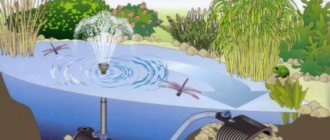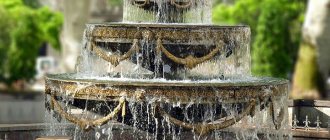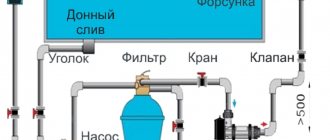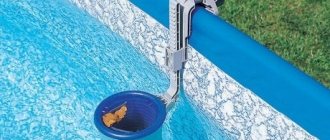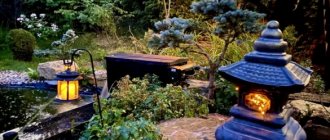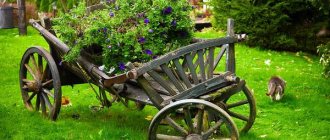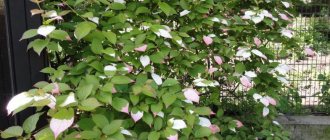A tastefully decorated and impeccably landscaped plot of land gives visual pleasure and restores strength. Cozy country corners with artificial ponds, cascading waterfalls, and enchanting fountains offer a special degree of relaxation.
To organize them, you will need specific pumping equipment, the installation and operation rules of which are worth familiarizing yourself with. Do you agree?
You will find all the most valuable and useful information about pumps for fountains and waterfalls on our website. We provide clear guidelines to help you choose the most suitable model with the necessary technical data.
Those who want to independently build a pond with special effects near a country house will find practical recommendations and diagrams for implementing an amazing idea.
We will describe the types of pumping equipment used in landscape design, give examples of construction and outline the nuances of installing equipment. An excellent addition to carefully selected and systematized information are collections of photos, graphic diagrams and videos.
Care and maintenance rules
The same water, circulating in a circle, gradually evaporates.
Adding a new portion is the very first thing you will have to deal with when operating the fountain. Periodically, the water must be completely replaced to avoid spoilage. Over time, dust settles in the liquid, contaminating it. The water becomes cloudy and an unpleasant odor appears. Simple measures can reduce the amount of dirt coming from outside - just cover the top of the fountain with any available material after each use.
When draining the water, it is necessary to clean all the internal surfaces of the fountain. The filter, attached to the pump nozzle, is rubbed with a brush.
Shading the fountain helps delay the blooming of water.
Before the onset of the winter months, all water is removed completely and the fountain is dried. The pump is removed and moved indoors until spring. If the device is planned to be stored in a cold room, after drying it is cleaned of deposits. If the room is warm, you can avoid the cleaning procedure by storing the pump in a bucket of water.
If the size allows and the fountain is mobile, it is moved entirely under cover. If not, the structure is covered with film.
In a pond equipped with a hydraulic structure, it is difficult to frequently change the water. Large debris floating on the surface is caught with a net with a long handle. The process of purifying a reservoir can be started by planting algae and populating it with mollusks. The stronger the pump nozzle sprays, the more oxygen the pond will receive - this also has a positive effect on the freshness of the water.
A properly selected pump and a creative touch in the design are all that is required for complete dacha happiness. They say that a person can look at fire and water endlessly. However, even five minutes spent near a murmuring fountain can give you a feeling of infinity.
How to make a slide for a waterfall
If you plan to decorate the edges of the waterfall with stones, and you want a high and large slide along which water flows, you need a solid foundation - a reinforced platform. Without it, the stones will slide into the bowl. Next to the pit for the bowl, the downhill area is cleared and reinforced.
They make a standard monolithic slab. First, a pit is dug. Its dimensions should exceed the hill by 40-50 cm in all directions. The pit is dug to a depth of 20-25 cm. Then the following order of work:
- Fill the gravel with a layer 10-15 cm thick and compact it well.
- Reinforcement with a diameter of 12-15 mm is laid. It is laid lengthwise and crosswise in increments of 20 cm, and at the intersections they are tightened with plastic clamps.
- Filled with concrete.
After the concrete has set (after a couple of weeks), you can begin laying out the slide. This procedure is necessary if the height of the slide above ground level is about a meter.
If the waterfall is planned to be small, you can simply remove the soil and pour crushed stone (you can lay geotextiles under it so that the crushed stone does not wash out into the ground). Compact the crushed stone well, pour a little sand on top and lay out a metal mesh made of thick wire. Place boulders on it, decorate it with smaller stones, pebbles, sand, and plant plants. This will turn out to be a kind of flower slide with a waterfall.
If the height of the waterfall is small, you can do without concreting the site
There is a second option - to make a cascade type waterfall using the height difference on the site. Even a slight slope of a few degrees will make the task much easier: steps are formed on the slope by laying stones in the form of slabs. If there is no slope, you will have to pour an earthen mound, carefully compacting each layer, not forgetting to form ledges. To reinforce slopes, you can use a polymer mesh. It is spread out and covered with earth. It will keep the soil from sliding.
A film is spread over the formed ledges, which is pressed against the riverbed with stones. They need to be laid out so that water from one stone falls onto another, and not onto the film. And then it’s a matter of design
Construction of a waterfall cascade
When forming a slide for a waterfall, it is advisable to fasten the stones together, even large ones, central ones, with a cement-sand mortar (1 part Portland cement, 3 parts sand and 0.5-0.7 water).
Pump equipment
Types of pumps for country fountains
To operate a fountain on a site, you need water pressure created by a natural drop or using pumps. Modern equipment is small in size and quite economical, so they usually use general-purpose pumps or specialized types designed for installation in garden fountains to circulate liquid.
It is possible to use submersible and surface pumps, each of which optimally suits certain conditions.
A rational step would be to combine the pump with solar panels
A modern view of the problem has led to the emergence of complete equipment for the manufacture of a floating fountain, in which a compact pump is combined with solar panels that provide it with electricity for operation.
This option is ideal in the question of how to make a mini-fountain with your own hands on a summer cottage or personal plot, eliminating a lot of the hassle and costs associated with installing a stationary system.
To install a submersible pump, the bowl must be deep enough to allow it to be placed at the optimal level. Therefore, when creating a fountain for a classic type garden, it is recommended to use such equipment. Water is sucked through the inlet and supplied under pressure to an outlet pipe connected by a pipe to a device designed to form a jet or stream of liquid.
It is somewhat more difficult to use a submersible system to build a cascade fountain made of stone with your own hands due to the fact that it does not always need a bowl, and the intake of recycled water can be organized in a miniature disguised container.
An outdoor pump eliminates the requirements for the depth of the reservoir and does not require electricity to be supplied to it. It can power both garden fountains with high water pressure and cascade ones, in which the dominant criterion is a significant flow rate of liquid at minimal pressure. For an example of how a solar-powered fountain works, watch this video:
However, such equipment has its own disadvantages:
- the external pump must be installed out of sight, providing some way to disguise it;
- a significant distance from the points of water intake and water supply negatively affects the efficiency of a self-made fountain and may require calculation of the pressure created;
- for the same reason, the length of the supply and discharge lines increases, which increases the cost and labor costs;
- the noise produced by the unit is not damped by a layer of water, leading to the need to soundproof the unit.
Rating of the best
Before you buy a pump for a fountain for your dacha, you need to pay attention to the rating of the best models. Popular in the market. First of all, you need to evaluate their advantages and disadvantages based on customer reviews that can be found on the Internet.
You should also not forget about some important technical characteristics of the devices: their performance, installation features, level of liquid lift and power.
SPRUT FSP-1843
This model has a relatively low power of 40 W. The device operates from a mains voltage of 220 V with a frequency of 50 Hz. The water supply of this pump reaches 1.8 cubic meters per hour. The pressure is limited to 2.5 meters. The engine speed is 3000 units per minute.
The manufacturer has provided 3 fountain nozzles for this model. Also included is a 5 meter long power cable.
The degree of protection of the device is IP68. It belongs to the submersible type of pumps. The guarantee for correct use of the model reaches 12 months from the date of purchase.
The main advantages of this pump include such features as:
- Compact overall dimensions.
- Easy to install.
- Quiet operation.
- Water method of engine cooling.
- The presence of suction cups ensures secure fastening.
The disadvantages of the model are as follows:
- Impossibility of use if there are contaminants in the water.
- Relative low power and performance.
This pump is designed for long-term use and operation of small fountains.
Leo XKF35P
This submersible pump has a motor power of 35 W. It works by connecting to a network with a voltage of 220 V and a frequency of 50 Hz. The water supply of this model is slightly lower than the previous one - only 1.2 cubic meters per hour.
The pressure of the device is 1.4 meters. The manufacturer has provided 5 nozzles for the fountain of various types. The length of the power cable is 5 meters. The degree of protection of the device is IP68. Its weight is relatively small - only 2.1 kilograms. The warranty period for using the device is 12 months from the date of purchase.
Buyers consider the following features to be the advantages of the pump:
- Affordable price.
- Ease.
- Small overall dimensions.
The disadvantages of this model are as follows:
- Low power.
- Can only be used in clean water.
- Not very high water pressure.
This device is quite sufficient if the decision has been made to organize a small fountain with a small amount of water.
ETALON XKF-35P
The motor power of this pump is 35 W. This submersible model operates from an electrical network with a voltage of 220 V and a frequency of 50 Hz. The productivity of the device is 1.6 cubic meters of water per hour. The pressure is limited to 1.4 meters. A distinctive feature of this pump is that its power cable is 10 meters long.
The standard protection level of the device is IP68. The same applies to the warranty period of use. It is 12 months from the date of purchase of the product in the store. The weight of the device is only 2.3 kilograms. The manufacturer included a fountain pipe and a set of several attachments for it.
Advantages of the model:
- Economical engine.
- Availability of a filter for water purification.
- Easy to care for.
- Stability of operation.
- Light weight and overall dimensions.
The disadvantages of the device include:
- Not very high power.
- Limited water pressure.
This model is ideal for those whose nearest source of electrical connection is located at a considerable distance from the fountain.
EUROAQUA THJ-1143
The motor power of this submersible pump is only 22 W. It operates from a mains voltage of 220 and a frequency of 50 Hz. Due to the characteristics of the power unit, the performance of such a device is not very high. It is only 1 cubic meter of water per hour. The pressure, in turn, is limited to 1.6 meters.
The engine speed per minute is 2850 units. The degree of protection of the device is IP68. Its weight is 1.3 kilograms.
The advantages of this model include such advantages as:
- Availability of a synchronous motor.
- Built-in filter for water purification.
- Water cooling system.
- Light weight.
The disadvantages of this device are very significant. Therefore, they are worth paying attention to. They are as follows:
- Low power.
- Insufficient equipment.
- Low water pressure.
This Chinese-made model has an affordable price.
STURM WP9704F
This submersible pump has a relatively high power of 40 W. It operates from a mains voltage of 220 V and a frequency of 50 Hz. The productivity of the device is 1.6 cubic meters of water per hour. The pressure in turn reaches 2.2 meters. The manufacturer has included 3 standard fountain nozzles in the kit.
A distinctive feature of this pump is the degree of protection IPX8. The weight of the device reaches 1.75 kilograms. The suction depth is 3 meters.
The advantages of this model are as follows:
- Adjustable water flow.
- Compact overall dimensions.
- Several types of nozzles.
- Economical.
- Availability of water purification filter.
- High degree of protection against moisture.
Disadvantages of the device:
- Not very high water pressure.
- Relatively low power.
This device can be used to create decorative landscape compositions, fountains and small waterfalls.
Pondtech CQP-1000F
This fountain pump has a power of only 16 W. It operates from a standard 220 V mains voltage with a frequency of 50 Hz. The maximum pressure of the device is 1.5 meters. Productivity is limited to 1 cubic meter of water per hour.
The length of the pump is 115 millimeters, width and height are 88 millimeters each. The manufacturer has provided lighting and 3 nozzles for the fountain. The length of the cable for connecting to the electrical network is 5 meters. The device has protection against possible overheating. The body is made of plastic.
The advantages of this model are as follows:
- Small overall dimensions.
- Availability of lighting and attachments.
- Ease of use.
- Economical.
The disadvantages include the following features of the device:
- Low power.
- Not very high water pressure.
Compared to other models, this unit has a relatively high cost.
STURM WP9709F
This submersible pump, in comparison with all those described above, is very powerful. Its motor is capable of reaching 95 W. It operates from a mains voltage of 230 V and a frequency of 50 Hz.
The water supply of this model is quite high. The productivity is 3.6 cubic meters of water per hour. The cable length is also significant - up to 10 meters. That is why the device can be connected to power without any problems. The manufacturer has provided 3 nozzles for the fountain.
An important feature of the device is also its degree of protection – IPX8. The weight of the device is 3.4 kilograms. The manufacturer equipped the devices with two pipes - main and additional. They are equipped with regulators that allow you to control the water supply. In order to ensure a long service life of the device, it has a filter to clean the liquid from some small impurities.
The advantages of this model, according to buyers, are as follows:
- Significant power.
- High water pressure.
- Long cable.
- Good degree of protection.
- Not a bad package.
- Long service life, etc.
The disadvantages of the device include such features as:
- Relatively significant weight.
- The cost is above average.
Despite the above disadvantages, the model is popular because its technical characteristics are better than other devices described above.
Connecting fountain pumps
An important element of the pump is the electrical cable, or rather its length. It is necessary to understand that the longer it turns out to be, the easier it will be to find a place to install the pump. A short electrical wire is of little use for organizing an outdoor fountain system.
When thinking over the pump connection diagram, it would not be superfluous to provide for the presence of a special tee. In this case, you will not have to run another wire to connect decorative lighting or additional filtering equipment. It would be wiser to calculate everything in advance than to correct shortcomings later.
The issue of cable insulation in the local area should be approached responsibly, since a damaged wire can cause dangerous situations. For safety reasons, it will be necessary to install automatic protection that can respond in the event of an accident. Connecting indoor fountains to the network is much simpler and, as a rule, does not cause difficulties.
Tips for choosing fountain pumps for your pond
Before choosing a device, you should understand the difference between pumping equipment for reservoirs and a fountain pump. Pond and filter devices are capable of transferring large volumes of liquid into the filter. However, they do not act as water purifiers. A common mistake that buyers make is to purchase a universal drainage model to equip a fountain, the main purpose of which is to pump water from drainage wells and basements. Such devices are not designed for long-term operation; their service life on average reaches 3000 hours. Fountain pumps for ponds have a service life that is tens of times longer than that of household devices. They can be used continuously for several years. The design features of such equipment allow the passage of large particles, sludge suspensions, clots of bacteria destroyed by reagents, etc.
Selecting a location
Depending on the type of structure chosen, the location for it is selected. It is necessary to approach this issue with greater responsibility than choosing a design. If this is done incorrectly, then you can end up with an area where various debris accumulates, and not a beautiful fountain. When choosing a site, you must consider:
- proximity of trees;
- proximity of buildings;
- prevailing wind direction;
- area completely open to the sun.
A fountain surrounded by trees looks attractive, but if the plants are close, it can create a problem. It consists of falling leaves and branches that will accumulate in the fountain. On the one hand, this will cause rotting processes, which will lead to the formation of silt and the need for frequent cleaning of the fountain.
On the other hand, debris will get into the pumping equipment, damage to which will require costs to restore functionality. The root system needs moisture, so it gradually begins to grow towards the fountain. The root system of some trees is so strong that it can destroy the structure.
It is worth considering the proximity of other buildings. Being too close to them will lead to increased humidity outside and inside the house. The consequence of this may be the appearance of mold and mildew, which are harmful to health and can render building materials unusable.
To choose the right location, it is necessary to take into account the prevailing wind direction. The wind will constantly carry away the spray and moisture-loving flowers can be placed in this place. If possible, it is necessary to position the structure on the leeward side. This will prevent debris from collecting inside the container that will be blown by the wind.
It’s nice to watch how drops of water shimmer in the sun, but placing a fountain in an area that is exposed to the sun all day is not worth it. One of the reasons is increased water evaporation. If you do not replenish its reserves, then if its quantity is insufficient, the sediment will fail. In addition, in the sun, water can heat up to high temperatures; considering that it circulates, there is nothing to cool it with. Elevated temperatures have a negative effect on the impeller and pump motor.
Types of fountains
Garden fountains are divided primarily into two main types:
- Decorative fountains.
- Pond fountains.
Decorative options are installed separately and have their own bowl. They have an autonomous water supply from the water supply. And of course, they have the most beautiful appearance.
Pond fountains consist mainly of a divider and a pump. In addition to them, you can purchase decorative decorations in the form of a jug, stones or other options.
Fountains also come in closed or open cycle. In a closed cycle, the water in the fountain is constantly circulating in a circle. In an open cycle, it is taken from a reservoir and returned to it. However, it is still flow-through.
Technical features of devices
In most cases, landscape designers use a pump for fountains or waterfalls, but there are also decorative complexes. This is typical for design ideas that emphasize the special style of the landscape.
Architectural compositions in the form of mermaids, corals and other marine-themed elements are often used as the final module of a water pressure system. For this purpose, there are special models of pumps that do a good job of supplying water.
Waterfalls can come in all shapes and sizes. The most common option is stylization to resemble natural objects, for example, a slide of river stones (+)
To add variety to the fountain, most manufacturers include several nozzles in the water unit kit that change the shape of the jet.
Filtering qualities are undoubtedly important for the proper operation of the system, but for the most part they do not provide bactericidal properties. Some fountains have this feature.
The effect is achieved thanks to hardware components, namely ultraviolet lamps. Systems with a cleaning module for removing microorganisms and their metabolic products are correspondingly more expensive.
As a result, the percentage of microbes causing water blooms has significantly decreased. Plus, ultraviolet radiation will have a beneficial effect on the fauna of the reservoir if you plan to breed river animals, for example, fry.
These properties are inherent, for example, in the Gardena FFP5000 . The disinfecting effect is fully felt only in reservoirs with a volume of up to 5000 liters. If the tank exceeds the recommended capacity, you need to install another model with a more powerful UV lamp - Gardena PF 15000S .
In addition, the decorative aspect of the fountain requires the presence of a special recess in the upper part of the sprinkler. The cavity can be filled with any material, be it crushed stone or other granulate. This design will fit well into a country house interior.
The popularity of the equipment is mainly explained by the relatively low price, and due to the small size of the unit, there will be no difficulties during its installation.
A large number of attachments will help create the desired atmosphere in your summer cottage. Today, the water pump package includes several nozzles
If a waterfall is planned on the site, it is better to use units that can pump dirty water. Such a device is not afraid of pollution and inclusions found in open natural reservoirs. Large fragments of algae, leaves, etc. will not disable them at all.
Therefore, to take water from natural sources, it is recommended to buy a surface pumping station, and to work in indoor pools and artificial ponds with pumped tap water, it is recommended to buy submersible ones.
Types of fountains
The classification of fountains is quite complex: they differ in design, principle of operation, type of spray, and may have additional functions, such as lighting or music. Let's consider the most popular designs used in decorating private households.
Submersible fountain
This type of fountain is used in artificial and natural reservoirs of sufficiently large size and depth. It is a submersible pump equipped with a sprayer and an electrical supply cable. It is enough to place such a pump in the pond and install it on a pre-prepared, level and solid area, and then connect it to the electrical network.
Submersible fountain in an artificial pond
The shape of the jet of a submersible fountain can be different and depends on the nozzles used; the most popular types of spraying are shown in Table 1.
Table 1. Types of water spray in a fountain.
NameDescription
| Jet | A single nozzle with a nozzle in the form of a truncated cone allows you to create a high output pressure and a high single jet, which breaks up into individual droplets. |
| Cascade | Several single sprayers with different nozzle diameters and water supply heights form a cascade of water jets. |
| "Bell" | A sprayer in the form of two disks, between which a stream of water comes out evenly. The smaller the distance between the disks, the thinner the water film. |
| "Tulip" | The design of the sprayer is generally the same as that of the “bell”, but cones are used instead of disks, as a result the water flow flows upward at an angle of 30-40 degrees, creating a funnel in the center. |
| "Fish tail" | The nozzles are located in a circle and deliver separate jets at an angle of 30-40 degrees, without forming a water curtain, as in a “bell”. |
| "Tiffany" | A combination of a “fishtail” and a “bell” - in the lower part the water flows out in a curtain, in the upper part - in radially arranged thin streams. |
Types of water spray in a fountain
Nozzles for jet type
floating fountain
Floating fountains are also used in large enough bodies of water where there is room for them to move. A floating fountain is a plastic housing in which a pump and a sprayer are installed. To clean the sucked water, a filter is provided at the bottom of the housing. The design of the fountain allows it to remain stable on the water surface. Floating fountains are often equipped with lighting.
floating fountain
Stationary fountain
The main difference between a stationary fountain is the bowl, which replaces the pond. The shape of the bowl and its dimensions can be absolutely any, as well as the installation location. Depending on the type of pump used and the number of sprayers, a stationary fountain can create any water compositions and effects. The fountain requires conservation for the winter.
Wall fountain
A type of stationary fountain, but a wall structure is installed near a blank wall of a building, near a fence or other massive element of landscape design. There are wall fountains with both jet spray and waterfalls. Cascading wall fountains look especially impressive.
Cascade fountain
Fountain-waterfall
To create a waterfall, it is not necessary to attach it to a wall; you can create a composition from stones, bowls or jugs. This fountain can be connected directly to the water supply. Water from the lower bowl is diverted into a storage tank or directly into the garden watering system.
Waterfall fountain made of ceramic bowls
Portable indoor fountain
The simplest and most inexpensive design that can be installed in the house, on the terrace or in the open air. The power of such fountains is small, but they add charm and style to the landscape.
Portable fountain
Selection and installation of the device yourself
You can arrange such a beautiful element as a fountain on your garden plot or dacha yourself. To do this, you need to decide on the place where it will be located and select suitable elements.
The pump for the tabletop fountain is chosen to be small, since the water container itself is small. For larger tanks, the pump must be appropriate. All this is indicated in the technical specifications for the device.
It is important to choose a hose of the appropriate diameter for the pump, because the quality of water pressure also depends on its size.
To connect a submersible pump, the cable must be double insulated and the entire installation requires grounding. Surface options are installed close to an artificial pond, but must be located in a box that will protect from precipitation in the form of rain.
To use the pump for both a fountain and a waterfall, you can install a tee on the pipeline. A filter and check valve must be installed at the end.
The need for pumps in the country. Pump types
One of the most beautiful structures that can be built on a site without much difficulty is a small pond with a fountain and a waterfall. The size of the reservoir can be any, it all depends on the area of the site. But so that it doesn’t look like just a small puddle, it needs to be beautifully decorated and defined as one of the recreation areas. It’s even better if water falls into this reservoir from a beautifully designed waterfall. To do this, you need to build a small slide with ledges, and supply water from a reservoir to its top, creating a closed cycle.
The water won't just run up. It is for these purposes that there is a huge variety of circulation pumps, designed specifically for the installation of small fountains and waterfalls in country conditions. All pumps necessary to create the normal functioning of a fountain or waterfall are divided into submersible and surface. Submersible devices are lowered into the water, and surface ones work from the shore of the reservoir.
In any case, they must work constantly, creating water circulation. If this is a waterfall, then the liquid from the reservoir flows to the top of the alpine slide, falls along the ledges, and returns back. Without a pump we will not get such a pattern of fluid movement. There are many types of such units that can work both underwater and on the surface.
Submersible pumps
For the most part, these are small in size and lightweight devices. They are installed on a special pedestal made of brick or concrete at the bottom of the reservoir. A pedestal is absolutely necessary, since a layer of sludge always accumulates at the bottom, and it will clog the suction valve and filter mesh. Four suction cups keep the device from moving during operation. Blades are mounted on the rotor shaft. When the engine starts running, the blades capture liquid and, under pressure, deliver it to the outlet.
Then the differences begin. If the unit is intended only for creating waterfalls and pumping liquid into a container for cleaning, then a hose is simply placed at the outlet. If it can also be used for a fountain, it has a slightly different design.
Let's look at the assembly of the kit using the example of a pump brand PFN - 25000 PLUS Aqua EI All parts that will be used are included in the delivery kit.
Latest postsIf you need to light a fire: 3 tips that will be useful in any situation New Year at the dacha: an excellent replacement for a boring celebration in the apartment Risk zone: for which a summer resident can be fined by law
- There is a threaded outlet at the top. A small adapter pipe is screwed in here.
- A tee with a tap is put on the pipe. The side exit is for a waterfall, the upward exit is for a fountain. The valve distributes the flow of liquid in directions. If you close it (that’s right, this is a design feature), then all the liquid will go to the waterfall, if you open it, everything will go to the fountain. The fact is that the fountain operates with low liquid flow, but requires high pressure. A waterfall does not need high pressure, but the water flow should be maximum. The tap opens slightly. This is determined empirically after starting the engine.
- A large head with LEDs and an outgoing electrical wire for connecting power is installed on top. When everything works, multi-colored rays will come out of the water and color the stream in all the colors of the rainbow.
- We insert an extension tube with a thread and a nut at the top into the head.
- If the nut is loosened, you can insert another extension tube, lower it to the size you need (from the water surface) and tighten the nut back until it stops.
- Now all that remains is to select a nozzle and put it on top.
Popular articles Eliminating bald spots on the lawn
Surface pumps
Surface units are installed in close proximity to the reservoir. They make a little noise and are afraid of rain. Therefore, they are usually covered with a casing or a special booth is made. The advantage is that they are on the surface and are easily accessible for maintenance. Such units have two outputs. On the side is for the suction hose, and on top is a hose that goes to the waterfall.
The suction hose at the end has a filter mesh and a check valve. When starting up for the first time, you must completely fill the hose and pump through a special hole and tighten the plug. After starting the engine, the liquid will begin to be pumped out, a vacuum is created in the hose and water is sucked in. If this does not happen or you cannot fill the hose for a long time, then you need to clean the check valve.
All pumps, submersible and surface, have a control panel. The small white button starts the engine. The rotary knob increases or decreases power (called outflow control), which affects lift height and pressure.
How to do it yourself
The commitment of our gardeners and summer residents to save money on almost everything, making the most incredible things from scrap materials is well known.
Our Kulibins and water pumps for supplying and pumping water to artificial hydraulic structures at their summer cottage did not escape our attention. An amateur engineer will need very few materials that can usually be found in any garage:
- Standard brackets.
- Multi-valve bushing to suit the requirements.
- Corrugated pipe corresponding to the dimensions.
- Fragment of a log.
- Industrial or homemade rubber valves.
On the video - how to make a mini pump with your own hands:
How to use a pump from a washing machine to make one for a garden fountain.
The pump is dismantled, washed and connected to the water supply system and power supply
With this option, it is extremely important to ensure reliable insulation, preventing access of water and contact with the electrical part and connection to avoid short circuits. No one will object that creating technical devices yourself is great, but it’s still safer to purchase from a manufacturer
This will guarantee safety, long and reliable operation. In the video - a do-it-yourself fountain from scrap materials:
Modern pumping units for circulating water in home, suburban and summer cottage areas are distinguished by a variety of models
They have a variety of performance indicators, technical characteristics and, most importantly, price levels. When choosing, you should take into account a lot of nuances and details.
The best option would be to obtain recommendations from a professional in this field or services for the selection and installation of equipment from specialized companies that have the appropriate licenses and permits to carry out work of this nature. Read about creating a recreation area with your own hands in this article.
Fountain as part of the decor
You can arrange a fountain in the garden, in the backyard or even at home, on every piece of land convenient for you. There are no limits to your bold imagination when it comes to DIY decorative fountains. Finishing materials made from natural stones or artificial crushed stone, light or heavy - the cost of the future system depends only on your preferences. A full-fledged fountain consists of a pump, pipeline, nozzles, bowl and other small parts. These are the main elements that ensure the correct operation of a complex system. What to do if there is simply no way to complete the structure with all the details? There is no need to immediately give up and refuse a tempting idea. Craftsmen, people who know a lot about their craft, offer various options in which you do not need a pump or electricity. A hand-made fountain will decorate a garden or pond in a short time, invariably delighting all residents of a country house for many years.
Fountain pump: overview of types, characteristics, and tips.
Fountains, waterfalls and other devices that use water have become popular decorations for a dacha or country house. Fountains give the dacha a special flavor and the garden landscape acquires its own uniqueness.
Installing a fountain is not a simple process. It is necessary to carry out calculations of the pipes and the power of the pump supplying water to the system. The pump for a decorative fountain determines the height and power of the water flow.
You should not choose a pump with a large power reserve, this leads to unnecessary costs. It is difficult to figure out which pump to buy without recommendations.
Types of pumps
Submersible ones operate at the depth of the water storage tank, so they are sealed.
Surface pumps are installed on land, but they are noisy; submersible pumps are less noisy.
The water in the fountain comes from a source, the source is a reservoir or a river. The reservoir allows for a closed fountain cycle with replenishment of the water level if necessary.
How to choose a fountain pump
Low-power pumps are used in mini fountains or waterfalls, but they must have enough power to raise the water to the required level. Each low-power pump has this technical characteristic. It should be taken into account that the mini pump requires a 24 volt connection, this should be taken care of in advance.
Pumps for decorative fountains must operate continuously for a long time, so their design includes a cooling system and a system for stabilizing other parameters to maintain a long service life.
The operating principle of a submersible pump is based on the use of a bladed rotor, which propels water as it rotates. The size of the blades and the speed of their rotation determine the level of water pressure in the system.
A submersible pump is installed at an elevation of the bottom in order to prevent silt, sand and other contaminants from entering the rotor part of the pump, which leads to its breakdown.
The mini fountain does not require special pipes that determine the type of jets; one outlet element is enough.
When it is necessary to create a spray of water, a special jet shape and other effects, fountain equipment includes transitional design elements that are installed on the pump outlets
It is important that all elements of the water supply are resistant to contamination during operation, otherwise the fountain will not fulfill its purpose of decorating the garden
Surface pumps require a protective cover against dust and rain.
The water intake hose must be equipped with a strainer and a check valve, which must be cleaned periodically. Contamination of these elements beyond measures leads to disruption of the pump and its further breakdown.
When choosing a pump, it is recommended to consider the main parameters of the unit that determine the choice. These include: performance level, power and liquid lifting height.
The performance level determines the water supply speed; this characteristic is indicated in the tables of the pump operating instructions.
The power characteristics of fountain pumps are distinguished by their energy efficiency. Considering the continuity of their work, this fact is important from the point of view of the fountain’s budget.
The height of the liquid rise is equal to the length of the vertical straight line from the water surface in the tank to the end of the outlet pipe raised to the level where water stops flowing out.
Recommendations for choosing pump manufacturers.
There are many manufacturers of fountain pumps. Using some examples, we will consider the characteristics of units for various fountains.
Pumps manufactured by PONDTECH are designed for various types of fountains. The HP series is designed for streams and waterfalls. The equipment in this series is characterized by high performance with a power of up to 900 watts.
Pumps from the manufacturer PONDTECH for fountains with additional equipment are designated the AP series. Products AR 388, AR 4660, AR 204, AR 3300 and others in this series have gained popularity on the Russian market.
Their rival manufacturers should highlight the Messner company, which is distinguished by its high build quality and reliability. The best products of this company are ECO-X2 4500 and ECO-X2 20000.
The models of these manufacturers have additional functions of protection against overloads and overheating that are attractive to buyers.
WHAT PUMP SHOULD I BUY FOR WATERFALLS AND STREAMS?
Before you buy a pump for a waterfall in your country house, you need to make a number of calculations. But first you need to make sure that the size and volume of the reservoir from which water will be taken allows you to create other water bodies on the site. As the water flows to the source of the waterfall, the water in the pond begins to noticeably decrease. Therefore, the surface area of the reservoir must be at least twice the area of the waterfall. If this is a reservoir of 40 square meters. m, then the total area of all objects (waterfall, stream) should be no more than 20 square meters. m. Before you buy a pump for a waterfall, its required parameters are determined. This is described in detail in the article on our website “Pump for a waterfall: how to calculate correctly?”
We are buying a pump for a stream for the dacha!
In general, you can calculate the required performance and pressure of pumping equipment for streams using the same formulas as for a waterfall. The performance of a stream pump depends on its width, flow intensity and the height of the water rising from the surface of the pond. For example, with a width of 0.5 m, a height of 1 meter and a normal flow rate, you will need to buy a pump for a stream of 6000 l/hour. When the height increases by 1 meter, 1000 l/hour is added to the equipment productivity. It is also necessary to take into account pressure losses when water moves through hoses. You can buy a pump for a waterfall and stream with the necessary characteristics, but not achieve sufficient pressure and water supply. It is better to choose hoses with a larger diameter (40-50 mm), since they have less losses.
Mini water pumps
Manufacturers offer a variety of mini water pumps, which can be divided into two types: submersible and surface. The former function exclusively under water, while the latter, on the contrary, are designed to work on the surface. Basically, miniature water pumps are designed for processing liquids with a small proportion of impurities, pumping clean water, various liquids with a low degree of viscosity, which are neutral and not aggressive towards the parts and elements of the pump itself.
Such devices are reliable, practical, easy to operate, safe to install, silent, and extremely economical. They are most often used in everyday life, although there are also special mini water pumps for machine tools. For example, a similar device is used with drills and machines for diamond drilling in walls and reinforced concrete floors. Such a mechanism is also indispensable in electric tile cutters, where mini water pumps are necessary for machines with water-cooled diamond saw blades.
In everyday life, products of this type can be observed in the operation of aquariums, washing car glass, in organizing the functioning of small fountains, various water compositions, cascades, waterfalls when arranging a personal plot, even in interior design in the form of water-bubble structures. Submersible pumps for mini waterfalls and fountains are the main equipment that is designed to create the necessary conditions for the operation of decorative hydraulic systems. The simplest, ordinary fountain is easy to build using a submersible design. But surface mini-pumps for water circulation are best used when installing not one, but several fountains with a large height difference. The advantages of such installations will only be visible if very high productivity is required. And for small landscape and design ideas, it is enough to purchase a low-power submersible unit. The pump for a mini waterfall or fountain must be installed so that the entire device is under water, but does not touch the bottom. Often, the unit is simply placed, say, on bricks. Water enters the mechanism through a filter and exits through a nozzle or goes through a hose to the desired location.
Guidelines for a thoughtful device purchase
The primary factors affecting the cost are the type of fountain and its power. Submersible equipment is usually more expensive than surface equipment, because in its manufacture, specific materials are used that are resistant to underwater pressure and constant contact with the not always harmless aquatic environment.
Surface pumps for constructing decorative waterfalls and fountains are suitable if water is drawn from open natural reservoirs
Manufacturers often include certain extras in the package. The presence of various modules and attachments is determined by the specific model of the unit. Visual effects that affect the price include the presence of backlighting and an ultraviolet emitter.
All of the above, of course, can affect the cost, but the main price range depends on the name of the manufacturer and the dimensions of the purchased fountain.
Variations of backlights are different. Manufacturers mainly provide the ability to switch a specific color using the remote control.
In order to optimize the choice of pump as much as possible and correctly evaluate the proposed functions from a practical point of view, you should be guided by a number of points.
Checklist for purchase:
- First of all, choose a device with a full set of additional extensions. This includes nozzles and hoses, a water flow control system, and several spray heads.
- Correctly match the size of the pool with the power of the unit.
- When organizing a multi-level fountain or waterfall, surface-type water installations show the best performance.
- High-quality models are resistant to corrosion. This should not be neglected, since the device is always in or near water. The correct choice of protective coating will significantly extend the life of the equipment.
- Always ask for the instrument's documentation. Make sure that the documents are authentic and that quality certificates are available.
- Pay attention to warranty features. Review the purchase agreement for service warranty clauses.
- When connecting the power supply, make sure that the system is equipped with a special fuse that can stop the current supply at any time. This is not a joke, because accidents often occur due to the violation of the hermetic sheath of power cables.
By observing all this, you are guaranteed to receive a high-quality product that will serve well for many years. Water fountain compressors come in a variety of shapes and sizes, and manufacturers are constantly making adjustments to the equipment, making it even more reliable.
